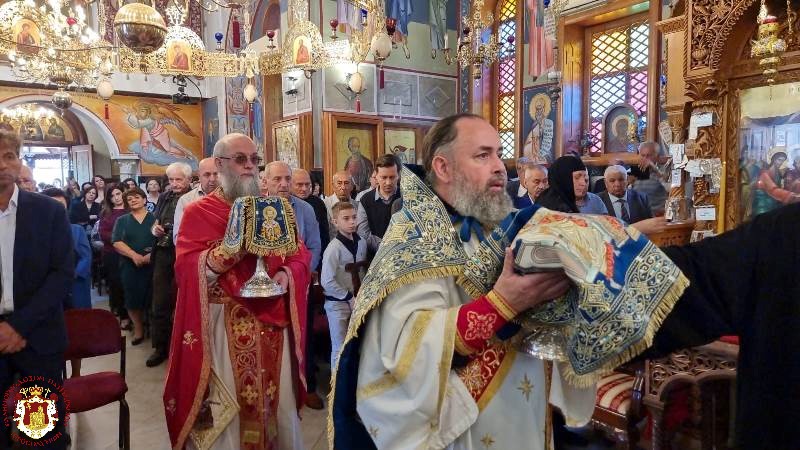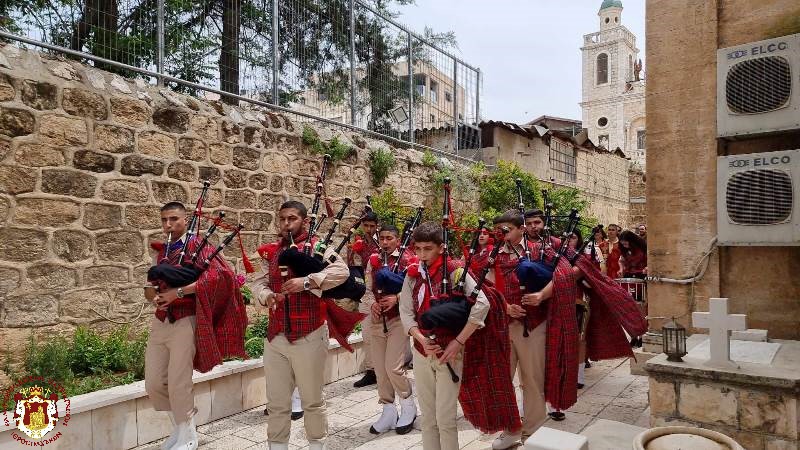Sunday of Thomas at the Patriarchate of Jerusalem


Sunday, April 10/23, 2023, was celebrated by the Patriarchate as Antipascha or Thomas Sunday, that is, as a commemoration of the fact that the Lord on the eighth day after His Resurrection appeared to the disciples again, as they were gathered in the Upper room with the doors closed when Thomas was also with them and He said to Thomas: “bring your finger here and put it in my side and do not be an unbeliever but a believer”, “because you have seen and believed in me, blessed are those who have not seen and believe”, (John 20, 27-29).
This event was celebrated during Vespers in the evening in the Catholicon of the Church of the Resurrection and the Divine Liturgy in the morning in the Holy and Life-giving Sepulchre, presided over by His Eminence Metropolitan Isychios of Kapitolias, concelebrated by their Eminences, the Metropolitan Ioannikios of Montenegro and Archbishop Makarios of Qatar, Hagiotaphite Hieromonks and deacons. The chanting was delivered by His Eminence Archbishop of Aristovoulos of Madaba and Hierodeacon Simeon. The service was attended by the Consul General of Greece in Jerusalem Mr Evangelos Vlioras and the Consul Mrs Christina Zacharioudaki and their families, as well as the pilgrims visiting for Easter.
After the end of the Divine Liturgy of the Resurrection, the Episcopal Entourage returned to the Patriarchate, where His Eminence received the pilgrims.
The event of the touching of Thomas was celebrated today also in the city of Cana of Galilee in accordance with the Status Quo of the Community of this town, the one after the event of the blessing of the marriage by the Lord, and the transformation of the water into wine. The Evangelist John mentions the first of these signs of the Lord (John 2, 1-11) in his Gospel, the passages of which are read on the Sundays after Holy Easter and until Pentecost.
His Beatitude our Father and Patriarch of Jerusalem Theophilos, being received by the Scouts, officiated this service with the co-celebration of their Eminences, the Metropolitan Kyriakos of Nazareth and the Archbishop Aristarchos of Constantina, the Hegoumen of Cana Archimandrite Benedictos, the Elder Kamarasis Archimandrite Nektarios and the Russian Priests of Galilee, Archdeacon Mark, Hierodeacon Eulogios and others.
To the assembled people, His Beatitude proclaimed the divine word as follows:
“Come let us drink a new drink, not one marvellously brought forth from a barren rock, but the Source of incorruption, which springeth forth from the grave of Christ, in Whom we are established”, exclaims Saint John of Damascus melodiously.
The grace of our Lord Jesus Christ, suffering by the Cross and abolishing death and rising from the dead, brought us all to this holy biblical place of Cana of Galilee, so that on Easter we may celebrate the manifestation of His [Christ’s] glory through signs, but also that of the inauguration of Christ’s Resurrection, as well as the touching of the Holy Apostle Thomas.
The Resurrection of Christ is the cornerstone of our Christian faith according to the testimony of the apostle Paul: “If Christ is not raised, therefore our preaching is empty because our faith is also empty” (I Cor. 15,14). Moreover, the Resurrection of Christ is the truth, the answer to Pilate’s question: “What is truth?” (John 18:38). This confession was proclaimed by the Lord Himself after parsimony, saying: “I am the way and the truth (John 14:6)… “I am the resurrection and the life” (John 11:25).
This confession was confirmed by Christ through His many appearances before His holy disciples after His Resurrection, as the Evangelist Luke testifies in His Acts, saying: “And [Jesus] appeared alive after His suffering [to the Apostles] in many witnesses for forty days, appealing to them and speaking about the kingdom of God” (Acts 1,3).
We also have the presence of Christ with us, my beloved brothers, through His divine-human body, that is, the Church, of which body He is the head, (Cf. Col. 1,18) according to Saint Paul. This does not mean that Christ Himself calls us to approach and touch His body as another Thomas, through our participation in the mystery of the “mystical blessing”, that is, of the Divine Eucharist, as Saint Cyril of Alexandria clearly teaches saying: “He comes” [=he visits] “and Christ appears to us all, invisibly and visibly; invisibly as God, and again visibly in the body. He [Christ] also allows his holy flesh to be touched. We draw nigh by the grace of God, in the making of the mystical blessing, receiving Christ in our hands, so that we too may [=properly] believe that He Himself truly raised the Temple”, [that is, His Body].
In other words, the communion of the Body and Blood of Christ constitutes a confession of the Resurrection of Christ, who said: “Whoso eateth my flesh, and drinketh my blood, hath eternal life; and I will raise him up at the last day. For my flesh is meat indeed, and my blood is drink indeed. He that eateth my flesh, and drinketh my blood, dwelleth in me, and I in him.” (John 6, 54-56).
The blood of Christ is the new drink, which we are called by the hymnographer to drink. And this drink gushes from the Tomb of Christ, it is the Blood of Christ, “the one poured out for many for the forgiveness of sins”. (Matthew 26,28). Interpreting the meaning of Christ’s blood and body, Saint Andrew of Crete, from Jerusalem, says: “Your body and Blood, crucified above all, did you lay down Oh Word; the blood to wash me; you gave the spirit to bring me, Christ, to your Creator”.
“This is what Jesus did at the beginning of the signs in Cana of Galilee and revealed His glory and His disciples believed in Him” (John 2:11). As you know, there are two signs that Jesus performed here, in the city of Cana of Galilee. On the one hand, the sanctification and blessing of marriage through His physical presence in it. “The honoured marriage was sanctified, and the[ancient] curse against the woman was abolished” says Saint Cyril of Alexandria. On the other hand, the transformation of water into wine by the unspeakable power of Christ: “By an unspeakable power the water was turned into wine. What is therefore [=difficult] to the all-powerful”? says Saint Cyril again.
According to Saint Clement of Alexandria, the wine at the wedding of Cana symbolizes the blood of Christ. “The scripture called the wine a secret symbol of holy blood. He proved again to the disciples that the blessed [water], was wine, saying: “I will not drink of the fruit of this vine until I drink it with you again in the kingdom of my Father” (Mt. 26,29).
In other words, the disciples of the Lord and all those who believe in Him will share in His joy and He in the joy of His disciples in the kingdom of His Father. “The drinking of wine does not only satisfy the need but offers to the senses the diverse pleasure; then the Resurrection from the dead, by which the decay of human bodies will have been removed and this nature of all things will be transferred to a place of renewal, so that even this joy of ours may be renewed by Christ Himself, our Saviour, Who instils His own innate joy into the souls of those who revere Him” says Saint Ammonios.
This, precisely, “the innate and unique joy of our Saviour Christ”, we too, my beloved brothers, are called to settle in our hearts during this time of the Resurrection of Christ, listening to the exhortation of the Theotokos who says: “Whatever he says to you, do it.” (John 2,5). And this is because the Risen Christ is He, “in whom we established”, according to the hymnographer Saint John of Damascus, invoking the Holy Bible which reads: “My heart is established in the Lord”, (1 Kings 2,1). Our firmness is none other than our faith in the Risen Christ (Cf. Col. 2:5), but also from the communion of the holy Body and Blood of Christ, who invites us all through the hymnographer exclaiming: “Come on this auspicious day of the Resurrection, let us partake of the new fruit of the vine of divine gladness and of the Kingdom of Christ, praising Him as God unto the ages” (Canon of Pascha, Ode 8, Troparion 1). Amen! Christ is Risen.
After the end of the Divine Liturgy, there was a litany three times around the Holy Church, with a large crowd of faithful Christians following in gladness, rejoicing and praying.
At noon during the meal that was offered for the Patriarchal Entourage, His Beatitude delivered the following address to those present:
“This chosen and holy day is the first of the sabbaths, the queen and lady, the feast of feasts, and the festival of festivals, wherein we bless Christ unto the ages” (Canon of Pascha, Ode 8, Heirmos), Saint John of Damascus exclaims.
Honourable President and members of the Ecclesiastical Committee,
Your Eminences,
Reverend Hegoumen Father Benedictos,
Beloved Brethren in Christ
The queen and lady of feasts, the feast of Pascha, has gathered all of us in the biblical and historical town of Cana to celebrate the event of the revealing of Christ’s glory through the signs which He worked in this holy place.
The active presence of the Church of the Rum Orthodox, namely of the Patriarchate of Jerusalem throughout the centuries is also witnessed by the Christian presence of the local Christian community which preaches and confesses the moral principles and values of love for one another, even for the enemies, of peace, conciliation and good coexistence with all the fellow citizens and religious communities who live here. “Behold, how good and how pleasant it is for brethren to dwell together in unity!” (Ps. 133,1) the psalmist proclaims.
This message is relayed to the whole world, given that Cana is inextricably linked with the great sacrament of marriage, which our Lord Jesus Christ blessed, but also with the divine power through which He transformed the water into wine.
Cana of Galilee is a biblical and historical place, attracting thousands of pilgrims and visitors and it is a source of blessing, hope, and strengthening as well as relaxation. “Come unto me, all ye that labour and are heavy laden, and I will give you rest” (Matt. 11,28) the Lord says.
We also experienced this during our blessed ministry as the Hegoumen and humble spiritual shepherd for the people in Cana, in particular for our pious flock.
Because of this, today’s company with you has special meaning, which refers to the unity between our Christian flock and the Patriarchate, according to Saint Paul’s order: “Endeavouring to keep the unity of the Spirit in the bond of peace” (Eph. 4,3).
The presence of the Christians in the Holy Land, and of course in this blessed town of Cana in Galilee is encompassed in this order of Paul. “We have an advocate with the Father, Jesus Christ the righteous” (1 John 2,1). This advocate is the Holy Spirit, Who brings together and sustains the whole institution of the Church, that is why the Lord says, “and the gates of hell shall not prevail against it” (Matt. 26,18), especially when it comes to the Holy Church of Jerusalem. Amen. Christ is risen!”
After the meal, His Beatitude made a Pastoral visit to the members of the congregation, which He had ministered in the past as an Archimandrite Hegoumen.
From Secretariat-General
Source: Jerusalem Patriarchate















































